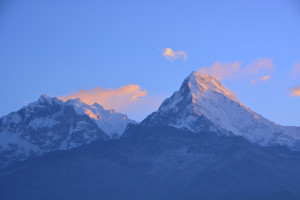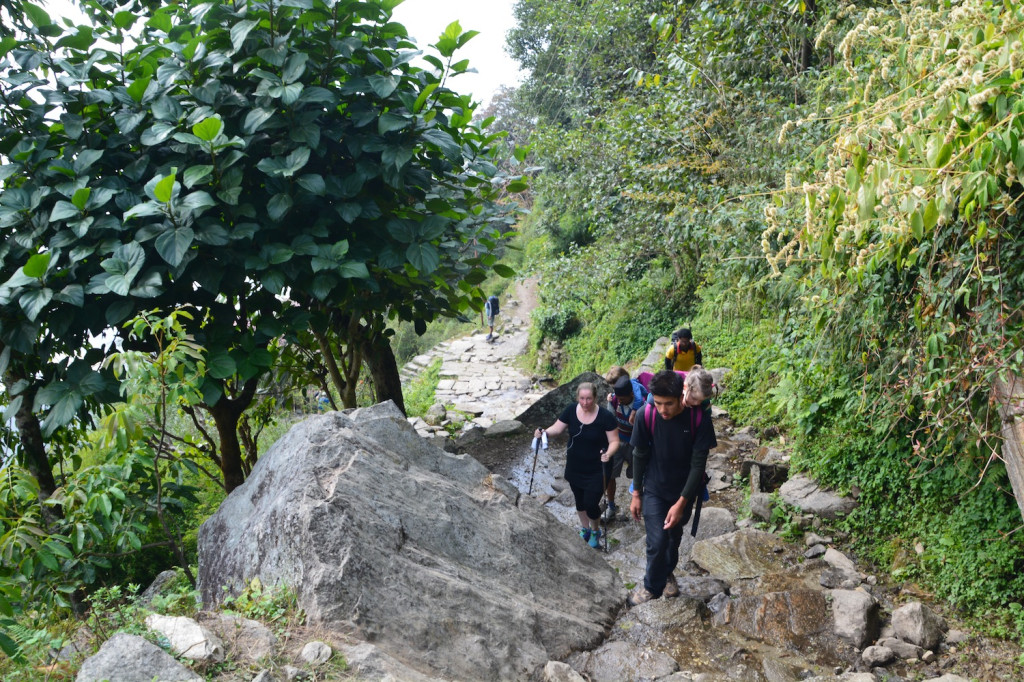Hi Ho! Hi Ho! It’s off to trek we go: Annapurna region with munchkins

Namaste! (pronounced Nam-ah-stay, with much-varied elongation and stress on the last syllable), is the traditional greeting in Nepal, whether between Nepalese or passing villagers or trekkers of all nationalities on the steep and rocky trails. I’ve now said it hundreds of times in a handful of different ways: mostly with a smile, sometimes with a grimace, often very quietly in an effort to conserve energy, with a loss of breath. Staffan and I were both fairly nervous before beginning our 6 day/5 night trek in the Annapurna region of the Nepalese Himalayas: bringing the kids on such an adventure was a definite risk—risk of accident or illness in a remote region, exhaustion, or worse, boredom. Not to mention I am far from being in great shape! Luckily, it turned out to be a wonderful adventure that will without a doubt be one of the top highlights of our entire trip.
There are hundreds upon hundreds of trekking companies in Kathmandu, and another slew based out of the lake-side town of Pokhara as well. We got down to choosing the right company based on recent tripadvisor reviews, proclaimed familiarity with trekking with children, responsiveness, and ownership. We chose a Nepalese-owned trekking company to recommend and guide our trek, Nepal Hiking Team. In only a few emails, we decided upon the Ghorepani-Poon Hill-Ghandruk trek as it at once affords great views of the Annapurna range as well as maintains a safe altitude for children (max altitude of 3200meters/10,500ft). It’s a tea-house trek, meaning that we didn’t need to worry about camping equipment or food: lodging is found along the trek at extremely rustic guesthouses with breathtaking, world class views. We arranged for a guide, a porter for our pack, and two more porters for the kids, just in case. We searched Kathmandu for child backpack carriers, concerned about the recommeded mode of transport suggested by our trekking outfit: pictures were shown to us of kids being carried in conical, woven baskets counterweighted by the heads and strong necks of the porters as they barreled down steep and narrow trails. After a few wrong turns and frustrating if not intentionally misleading taxi rides, we finally made it to the “new mall” on the outskirts of the city, where we found aluminum framed carriers, most likely recommended for babies under 1 year old. Staffan reviewed the construction, and test ported the kids around the store: we were all set.
This well trodden trek starts out with a 2 hour drive from Pokhara ascending up and descending down steep, terraced rice paddy hillsides to Naya Pul, a one street town with blue-painted, corrugated metal shops selling water and last minute trekking supplies such as temperature cycled snickers bars and toblerones that crumble to the touch. We started out gently, walking through the town, receiving many Namastes aimed at the kids, and listening to Phineas ask, “are we there yet?” about 20 times. We quickly reached a point where one veers off the road down a steep muddy path, past a cobra monument and over our first of many suspension bridges. As we ascended out of the town and onto the dirt trail, Phineas reluctantly quieted down, and started to take on his role as spotter of wildlife. Eilir vociferously assumed the role of directing us all with her 50m viewpoint, “Next stop: waterfall! Next stop: bridge!”, etc. The true ice breaker among the group was the pure excitement the kids displayed at being pushed to the side of the path by herds of sheep, goats, or donkeys carrying wares up the mountain. Phineas and Eilir, prone to giggles at toilet talk, started a long and deeply fascinating conversation about the differences between mule dung, horse poop, and what they decided to be donkey diahrhea. At this point, it was clear to all the adults that kids are the same everywhere, and the ice was broken among us. Phineas and Eilir were shy at first, reluctant to be carried by strangers, but by the end of the first day of the trek, they were completely opened up and treating the team as their trusted friends (and playmates).
We reached our first destination of Hile at 1430m (4700ft) in only 4 hours of hiking. When we arrived at our guesthouse, we were delighted by the gorgeous views across the valley of the terraced rice paddys arduously being worked, and the neverending supply of tea—mint, masala, milk, black—you name it. Word spread fast that small kids were on the trek: within 30 minutes we were surrounded by village kids, all excited to inspect Phineas and Eilir’s small cache of toys allowed on the trek. Aged 11 down to 5, we were able to converse with them readily as the older ones already had a solid command of English from school. Gold Haribo gummy bears were rationed and shared with all.
Day two was supposed to be the hardest day: ascending 1000meters or 3000ft over a very steep stone staircase with 3200 steps. I was not looking forward to it at all, but the thought of gaining the altitude and achieving clear mountain views was enough to keep me going. Whereas the others were allowed to take breaks, I know myself well and knew that stopping would be a disaster, so I plodded on to the top, like the tortoise that reaches the finish line to tie the hare (aka Staffan). We found beds for the night at a guesthouse perched on the side of the mountain that had a garden resembling what the kids dubbed, “the end of the world”. Phineas and Eilir had to be very careful not to run past the sheet-covered laundry lines that billowed in the wind, outlining the grassy lawn, as the drop on all sides was precarious. No amount of hiking can tire Staffan out: he proceeded to play tag with the kids, throw them into the air, and impress our group and others with his ability to jump up onto rocky outcrops and balance on the tops of poles after the day’s climb. After a few rounds of Hide and Seek, we had exhausted the hiding possibilities at this small outpost, and settled in for an evening of reading and tea.
I was assured that day three was supposed to be flat with some gentle climbs: only 500 meters / 1600 ft of altitude needed to be gained. Let’s get one thing on record: there’s no such thing as “flat” in Nepal. Nepalese flat means climbing up and down over ridges to maintain a similar average altitude. It was a difficult day, made moreso by the disconnect in expectations. All the same, we arrived in Ghorepani for a late lunch, excited to be nearly at the pinnacle of our trek. Our gueshouse was a pleasant surprise: we got the corner room with views on 3 sides, and the communal area was large enough for the kids to take the run of the place, beating out their energy by playing transformers. We got a tour of the kitchen and a lesson in momo making from the matriarch of the family, and also the executive chef! She definitely had 10,000 hours of experience with momos, so it’s safe to say we learned from an expert. The last remaining altitude climb was the 350m / 1100ft climb up Poon hill, that Staffan tackled the following morning to starlit skies at 5AM to watch the sun rise at 6:10AM. I stayed back closer to our sleep-filled kids, climbing a mini-Poon hill behind the guesthouse to watch the night recede. It was a spectacular sunrise, as clear as could be, with stunning views of Dhaulagiri, Annapurna, and Fishtail peaks, each receiving their first light in line as the sun worked its way over the horizon. It felt like Christmas, the mountains slowly unwrapping themselves before us.
The hike to Tadapani was another Nepali flat day, with very a very high amplitude swing. This time, however, my expectations were set correctly, so it was a more pleasurable 6 hours of hiking. The terrain changed from the previous days’ rocky paths clinging to the hillsides to that of a wet and musky forest, reminiscent of the redwoods in Northern California. The walking path undulated through the trees, every so often offering expansive views of the Himalayas, but mostly keeping to itself. It was a quiet day, the sound of our group’s footsteps rambling over exposed tree roots, carefully balancing on wobbly rocks over waterfall crossings, the moss moist and a welcome cushion to tired heels. Tibetan prayer flags and cairns could be found at most well worn resting spots. Even the kids seemed to absorb the peaceful beauty of the day.
We were very cold in Tadapani, at 2710meters. Phineas and Eilir pretended to be dragons, breathing smoke from their tiny lungs. Since we had planned our trip for the tropics, we ended up wearing absolutely everything we owned to keep the shivers at bay. We played memory and go fish with the kids and our guides by a smoky fire, unaware of the panoramic mountain vistas that surrounded us, for a deep fog had rolled in before we ascended the final ridge to the guesthouse. Waking to another gorgeous sunrise, the morning uncovering a view to Annapurna South and Fishtail, but shivering cold, we decided to double up days 5 and 6 into one and hike all the way back to Naya Pul. The porters were happy as this would allow them to reach their families in time for the most important day of Diwali, the festival of lights. The walk was relatively easy on the cardio side, but a killer for the knees, descending 1650meters (5400feet) over steep, slippery steps and forest paths. In the end, it was a brilliant choice, as I came down with a terrible cold and would not have been able to hike down at all had we stayed another night on the mountain.
So, that’s the story of our Annapurna trek: done with help from a team of great people, forging friendhips and being humbled by the beautiful views along the way. Phineas and Eilir have their first real exposure to turning seemingly impossible, distant goals into what’s possible to physically walk and achieve. According to our somewhat dubious fitbit, we took 104,374 steps covering some 43.6 miles (70km), and climbed over 1000 flights of stairs. We experienced authentic rural village life, and gazed with awe at some of the most ambitious peaks in the world. It was an international adventure as well, as we met many fellow trekkers from around the world, up to 73 years old (!), each keen to understand how the kids fared on the path. It’s hard to describe the feeling of accomplishment, from even such a small trek by Nepal standards (many people we encountered were doing 18+ day Annapurna circuit, Annapurna Base Camp (ABC), or had finished Everest Base Camp (EBC) treks), but for us, this was just strenuous enough to be an accomplishment, remote enough to be special, and crisp enough to forever burn the rocky images of the top of the world into our memories.
Comments are closed.




































































WOW! Breathtaking!
Namaste…..globe trxstrs. You guys are absolutely the best for sharing this
site and all your inner thoughts and Beautiful !!!! pictures along the way.
What a fantastic voyage….by the way I was convinced you were in a movie of
the same genre as I am most gullible and therefore not ready to take on the
world as you guys are so apt at. Seriously living vicariously….. Keep on
trucking.
Much Love to you ALL,
Dick and Kara